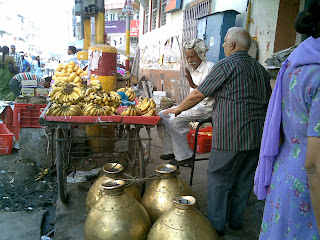Amritsar is a big city. There are shops, big and small, on either side of the road. Our bus stopped at a hotel which was clean and looked like a three star hotel. We were provided clean rooms and that was indeed a relief. After a wash, I jumped into my bed and fell asleep in no time.
The next morning we woke up early as we had to go to the Golden temple. Our guide asked us to dress up early and that we had to leave by 6:30 am. We left after a cup of coffee from the restaurant.
The bus stopped at the parking place. A number of horse carriages could be seen. We had to take the carriage to go to the Golden Temple.
The carriage stopped around a junction and we had to walk it down to the Golden Temple. There were shops on either side of the road. The road leading to the temple is narrow. In spite of narrow roads there were shops on either side of that narrow road. We entered the temple and we had to leave our footwear in a counter. The guide then told us that we had to keep our heads covered inside the shrine. At the entrance, there was a small place where we had to wash our feet before entering the shrine.
As I entered the shrine a loud voice stopped me. The man was a huge sized Sikh who said something in Hindi looking at me. The guide asked me to cover my head with my dupatta. Though I had covered my head, the dupatta had slipped off. As my hair is very short and silky, the dupatta couldn’t stay intact. After that I was very cautious to see that my dupatta was in place.
The causeway to Hari Mandir is of marble. There is a big tank called Sarovar which is said to be fed by an underground spring. The causeway encircles the Harimandir and the tank. Hundreds of pilgrims come here every day. There were Sikhs at regular intervals holding a long javelin sort of thing. They are supposed to keep watch of the temple. It was very colourful to see Sikhs wearing colourful turbans. It was a long walk from the clock tower to Hari Mandir. The entire region is clean and the atmosphere serene and pious. Photography is prohibited at the shrine.
The temple is made of gold. There were Sikhs inside the temple with their holy book, the Granth Sahib on a raised platform. There is a canopy above this. They wave a fan like thing called the ‘chaur’. It is treated with very much respect. I did not enter the gurudwara. I stood outside the shrine and watched it. It is a three storied building. I went around the other places.
Food was served at places. I heard a man saying that anyone could go to their dining hall for food. Jenny and I found a place where they were serving a kind of burfi rich in ghee. I had a pinch of what Jenny took from him. It was tasty.
We came out of the shrine and staright went for shopping. I bought the three K’s of the Sikhs. Though there are five K’s I could only buy three. The five K’s are
1. Kesh – The uncut hair of the Sikhs. (I always keep my hair very short)
2. Kanga – A wooden comb. I bought it though I don’t wear it.
3. Kara - An iron bangle. I bought it and wore it.
4. Kachera – It was an innerwear for men. It is worn by the Sikh soldiers. I didn’t buy it,coz it was of no use to me.
5. Kripan – A small dagger worn by Sikhs. I bought the original kripan. There were Kripans imported from China which was relatively cheaper.
The Sikhs also had a kind of bangle with beads. They said it was used for prayers. I bought it too. We came out of the building and walked straight to Jallianwalah Bagh. We had to walk in between two buildings which was a very narrow lane.
Very frankly, there was nothing much to see here except for the martyr’s well where many people fell when Gen. Dyre opened fire on 20,000 people on 1919 and a memorial built in memory of the massacred people.
The main street is a typical Indian town with lots of people and unhygienic surroundings. I saw big pots of curd outside many shops. They sold lassi which was a sweetened curd.
After breakfast we left Amritsar for Kurukshetra






No comments:
Post a Comment